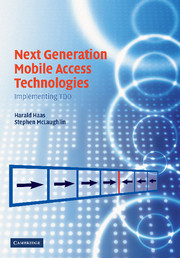Book contents
- Frontmatter
- Contents
- List of abbreviations
- Acknowledgements
- 1 Introduction
- 2 Wireless telecommunications using CDMA and TDD techniques
- 3 Interference and capacity analyses
- 4 Centralised DCA algorithm using the TS-opposing idea
- 5 Distributed DCA algorithm utilising the TS-opposing idea
- 6 UTRA-TDD Opportunity-Driven Multiple Access (ODMA)
- 7 Routing strategies in multi-hop CDMA networks
- 8 Multi-hop DCA
- 9 Radio resource metric estimation
- 10 Interference-based cancellation techniques for TDD
- 11 Smart Antennas for TDD-CDMA Systems
- 12 Cellular OFDMA-TDD
- 1 Derivation of T: Unconstrained Optimisation
- Bibliography
- Index
7 - Routing strategies in multi-hop CDMA networks
Published online by Cambridge University Press: 02 September 2009
- Frontmatter
- Contents
- List of abbreviations
- Acknowledgements
- 1 Introduction
- 2 Wireless telecommunications using CDMA and TDD techniques
- 3 Interference and capacity analyses
- 4 Centralised DCA algorithm using the TS-opposing idea
- 5 Distributed DCA algorithm utilising the TS-opposing idea
- 6 UTRA-TDD Opportunity-Driven Multiple Access (ODMA)
- 7 Routing strategies in multi-hop CDMA networks
- 8 Multi-hop DCA
- 9 Radio resource metric estimation
- 10 Interference-based cancellation techniques for TDD
- 11 Smart Antennas for TDD-CDMA Systems
- 12 Cellular OFDMA-TDD
- 1 Derivation of T: Unconstrained Optimisation
- Bibliography
- Index
Summary
Multi-hop relaying routing protocols have been investigated for CDMA air interfaces in conventional cellular scenarios, as described in Chapter 6 and in (Harold and Nix, 2000a) (Harold and Nix, 2000b). This chapter compares the performance of ODMA with direct transmission for cases where links maybe required directly to other nodes, as well as to a controlling (backbone) node, and presents two new routing algorithms.
For an interference-limited system, it is shown that the topology cannot be supported by a conventional (single-hop) system, but that a relayed system is able to provide service. As an enhancement to path loss routing, a new admission control and routing algorithm based on receiver interference is presented which is shown to further enhance performance.
A second new routing algorithm, which considers the interaction between all receivers in the system by means of a ‘congestion’ measure is presented. This approach allows for routing that is optimised for the entire system, not just a particular route under arbitrary starting conditions. This is possible under both central and local parameter gathering scenarios. Through formulating this measure into the power control equations it is possible to determine system feasibility, although this is a conservative criterion due to approximations in the formulation. This congestion-based routing is shown to outperform non-relaying and any previous routing technique in available capacity for the new network topologies, and has the lowest transmitted power requirement of all investigated methods.
Information
- Type
- Chapter
- Information
- Next Generation Mobile Access TechnologiesImplementing TDD, pp. 186 - 213Publisher: Cambridge University PressPrint publication year: 2008
